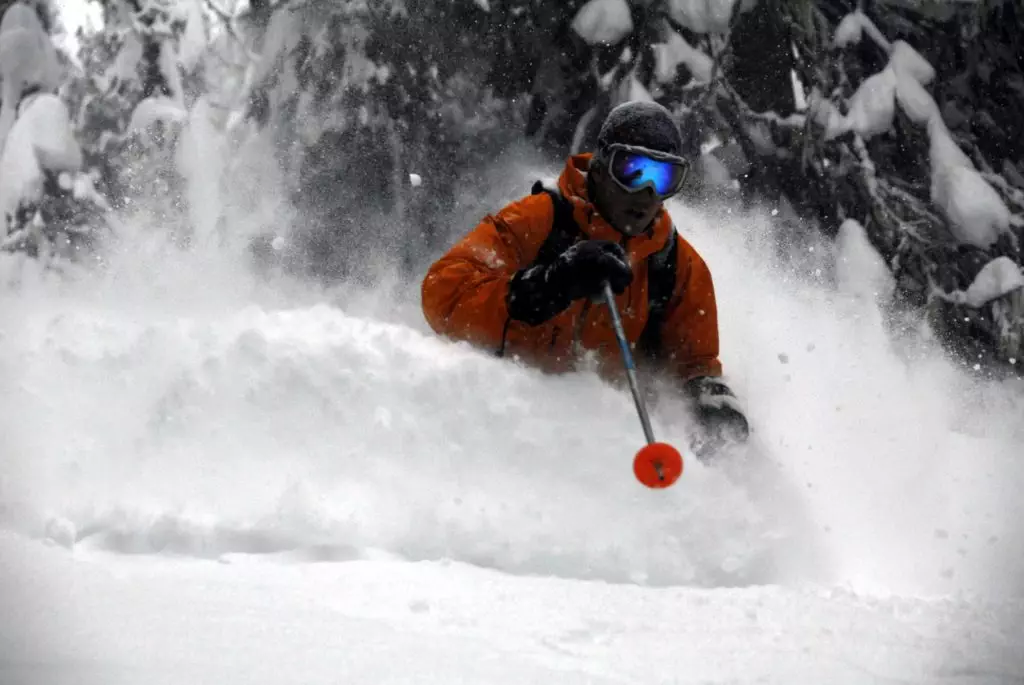Whistler and the whole of the Pacific Northwest is rejoicing this week after winter broke down the door with well over a meter of snow on the slopes and more in the forecast. What a time to be alive! But while everyone is busy ditching work getting faceshots, there remains a life threatening hazard at every turn, and I’m not talking about avalanches.
Snow Immersion Suffocation (SIS) can happen when a skier or snowboarder falls into a tree well or deep, loose snow – usually headfirst. If the victim is inverted, they can become immobilized and unable to self-rescue, causing them to suffocate.
More than just trees…
As skiers and snowboarders in British Columbia, we’re often taught about the dangers of tree wells. Evergreen trees such as fir and hemlock often have large, deep tree wells that form when low hanging branches obstruct snow from naturally filling in and consolidating around the base of the tree. These voids are often hidden from view, especially after large snowfalls.

Large, unconsolidated snowfalls – such as the storm cycle we’re currently receiving in Whistler – can make all sorts of natural features into hazards. Creek beds, troughs, pretty much any depression in the terrain can create a pocket of snow that can trap unsuspecting skiers and snowboarders. Yes, you have to be unlucky. But it happens. Personally, I’ve had two friends involved in serious tree well accidents. One was lucky enough to be rescued in time by strangers skiing by. My other friend died before help arrived.
How to avoid SIS accidents
Telling skiers and snowboarders to not ski in the trees on a 50cm powder day is about as useful as orange juice at apres. So how can we prevent these accidents?

Ski with a buddy AND watch each other’s backs
“Buddying up” in the trees is one of the best safety nets for SIS accidents, but humans being humans, we sometimes get carried away with the euphoria of deep powder turns and don’t turn around to check on friends until we get to the bottom of the run. If a one person falls into a tree well and is immobilized, their buddy will only be helpful if they can get to them quickly. Make sure to keep each other within sight or within earshot, preferably both. If you don’t see or hear them, stop and call out before continuing down the run. Cat skiing guides will always do this with a loud “HEYYYY HO!” to make sure their clients all arrive in the same spot. You can use the same technique to maintain communication with your buddy.
Ski defensively
Another one that’s easy to forget about in the moment. If skiing in the trees, resist the temptation to slash all those powder stashes piled against the base of the trees. Falling in feet first usually just means digging yourself out, but head first can be fatal. Consider choosing gladed runs (trimmed trees have better spacing and less low-hanging branches) or stick to the open slopes. But after huge snow falls, remember SIS traps can be anywhere.

Track each other’s location
Smart phone technology has made it easier than ever to pin-point one’s geo location. When skiing with your friends on powder days, it’s worth having an app open on your phone where you can quickly check where your friends are and more importantly, if their blue location dot is still moving. There are plenty of family/friends tracking apps out there but few that are mountain-specific. My favourite app for Whistler by far is ULLR Adventure Maps, which is also the most comprehensive map ever made for Whistler Blackcomb Mountain. If two (or more) friends are using it, they can track each other’s locations and, if an emergency arises, you can call ski patrol with the victim’s exact location (ULLR was developed by a Whistler ski patroller using maps refined over decades for quick response times). Remember, however, both friends must have purchased the app and have it running on their phones to be able to locate one another.
WHat To do If you fall in a tree well in the snow
- Firstly, carefully grab at branches, the tree trunk or anything solid that can prevent you from sliding further into the hole.
- Try to avoid struggling after you have fallen in. Doing so will only lead to more snow caving in on top of you and you sinking further in the hole.
- Do your best to make an air pocket around your face and mouth. This can buy you precious time while you wait for your partner or helpers to make their way to you.
- Yell or whistle to get your partner’s attention or that of other skiers passing by. Stay as calm as possible to preserve air.
- Carry a whistle close to your face in either a chest pocket or on your front zipper.
Stay vigilant against SIS, especially after big snow storms
There’s nothing like a big snow storm to turn ski town frowns upside down, especially if its inhabitants have been snow-starved for a while. But when there’s big swell and not a lot of skier compaction in between cycles, the chance of SIS increases dramatically. Don’t let you or your friends become another statistic. Learn more about wilderness first aid or avalanche courses. Prepare yourself with avalanche training to keep you and your friends safe this winter.
https://vimeo.com/51002307 Written by: Vince Shuley

